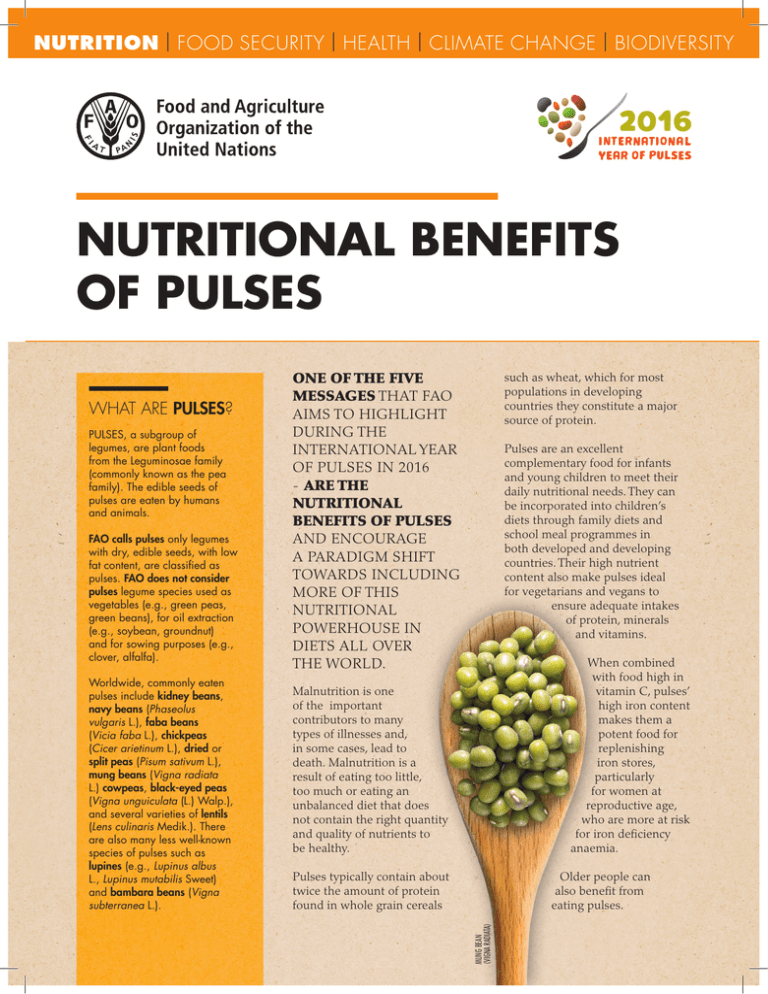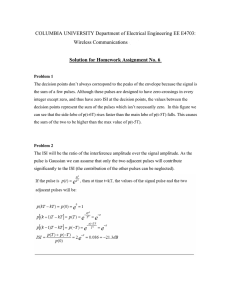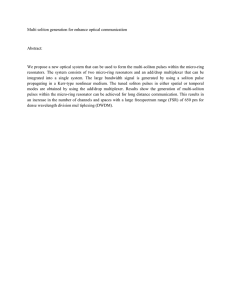NUTRITIONAL BENEFITS OF PULSES
advertisement

NUTRITION | FOOD SECURITY | HEALTH | CLIMATE CHANGE | BIODIVERSITY NUTRITIONAL BENEFITS OF PULSES PULSES, a subgroup of legumes, are plant foods from the Leguminosae family (commonly known as the pea family). The edible seeds of pulses are eaten by humans and animals. FAO calls pulses only legumes with dry, edible seeds, with low fat content, are classified as pulses. FAO does not consider pulses legume species used as vegetables (e.g., green peas, green beans), for oil extraction (e.g., soybean, groundnut) and for sowing purposes (e.g., clover, alfalfa). Worldwide, commonly eaten pulses include kidney beans, navy beans (Phaseolus vulgaris L.), faba beans (Vicia faba L.), chickpeas (Cicer arietinum L.), dried or split peas (Pisum sativum L.), mung beans (Vigna radiata L.) cowpeas, black-eyed peas (Vigna unguiculata (L.) Walp.), and several varieties of lentils (Lens culinaris Medik.). There are also many less well-known species of pulses such as lupines (e.g., Lupinus albus L., Lupinus mutabilis Sweet) and bambara beans (Vigna subterranea L.). such as wheat, which for most populations in developing countries they constitute a major source of protein. Pulses are an excellent complementary food for infants and young children to meet their daily nutritional needs. They can be incorporated into children’s diets through family diets and school meal programmes in both developed and developing countries. Their high nutrient content also make pulses ideal for vegetarians and vegans to ensure adequate intakes of protein, minerals and vitamins. When combined with food high in vitamin C, pulses’ high iron content makes them a potent food for replenishing iron stores, particularly for women at reproductive age, who are more at risk for iron deficiency anaemia. Malnutrition is one of the important contributors to many types of illnesses and, in some cases, lead to death. Malnutrition is a result of eating too little, too much or eating an unbalanced diet that does not contain the right quantity and quality of nutrients to be healthy. Pulses typically contain about twice the amount of protein found in whole grain cereals Older people can also benefit from eating pulses. MUNG BEAN (VIGNA RADIATA) WHAT ARE PULSES? ONE OF THE FIVE MESSAGES THAT FAO AIMS TO HIGHLIGHT DURING THE INTERNATIONAL YEAR OF PULSES IN 2016 - ARE THE NUTRITIONAL BENEFITS OF PULSES AND ENCOURAGE A PARADIGM SHIFT TOWARDS INCLUDING MORE OF THIS NUTRITIONAL POWERHOUSE IN DIETS ALL OVER THE WORLD. NUTRITION | FOOD SECURITY | HEALTH | CLIMATE CHANGE | BIODIVERSITY GETTING THE MOST FROM YOUR PULSES In many cultures, pulses are considered as ‘protein for the poor’. There are a number of reasons why they are underestimated. The most common ones are: they can cause bloating, flatulence, and, unless they are soaked for hours, pulses take a long time to cook. Pulses contain some anti-nutrients, which are substances that reduce the body’s ability to absorb the various minerals that pulses contain. Fortunately, many of these issues (bloating, flatulence, anti-nutrients and length of cooking time) can be overcome using traditional cooking techniques, such as soaking, germination (sprouting), fermentation and pounding. Traditional methods can also help to reduce the content of the anti-nutrients. When other foods are combined with pulses, the nutritional value of pulses is further enhanced, as other foods help to ensure that the body is able to better absorb all the nutrients found in pulses. Here are a few examples: 1. When beans are eaten with other foods such as grains, the nutritional value of pulses is even greater as the body is better able to absorb iron and other minerals found in pulses. KEY FACTS ➤➤ With a low glycemic index, low fat and high fibre content, pulses are suitable for people with diabetes. Pulses increase satiety and help to stabilize blood sugar and insulin levels by reducing spikes after eating and improving insulin resistance making pulses an ideal food for weight management. ➤➤ Pulses may reduce the risks of coronary heart disease. They are high in dietary fibre, which is well known for reducing LDL cholesterol, a recognized risk factor in coronary heart disease. ➤➤ Pulses are good sources of vitamins, such as folate, which reduces the risk of neural tube defects (NTDs) like spina bifida in newborn babies. ➤➤ Pulses’ high iron content makes them a potent food for preventing iron deficiency anaemia in women and children especially when combined with food containing vitamin C to improve iron absorption. ➤➤ Protein quality matters, particularly for growth and development. The protein quality of vegetarian diets and plant-based diets is significantly improved when pulses are eaten together with cereals. 2. Another way of increasing the body’s ability to absorb iron is to combine pulses with vitamin C rich foods (a good example is to sprinkle some lemon juice on lentil curry). CO 3. Drinking tea or coffee with meals, on the other hand, has the opposite effect. MM ON BE A NS There are so many ways to eat pulses. (PH ASE OLU They can be eaten at any meal. In some Asian S VU LGAR IS) countries, boiled chickpeas, mung beans and butter beans are a common sight at breakfast. They are also a favorite snack. In other parts of the world, bean burgers or falafel, made from ground chickpeas or fava beans or both, are eaten for lunch. Pulses, especially beans, can be added to soups, salads, and pasta sauces. In some parts of Italy, boiled beans and tuna fish is a common second course. Even children as young as six months can enjoy a puree of boiled pulses with other foods. ➤➤ Pulses are gluten-free. ➤➤ Pulses are rich in bioactive compounds such as phytochemicals and antioxidants that may contain anti-cancer properties. ➤➤ Pulses promote bone health. ➤➤ Phytoestrogens may also prevent cognitive decline and reduce menopausal symptoms. #IYP2016 fao.org/pulses-2016 © FAO 2016 I5384E/1/02.16



